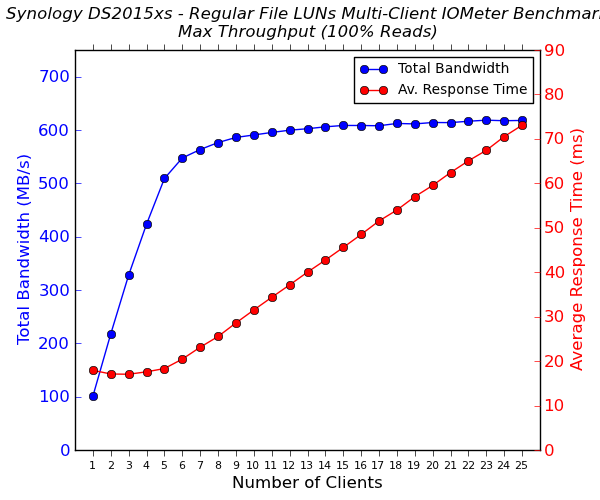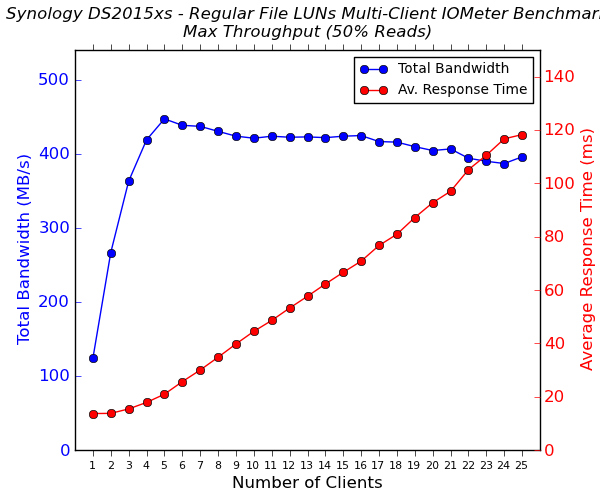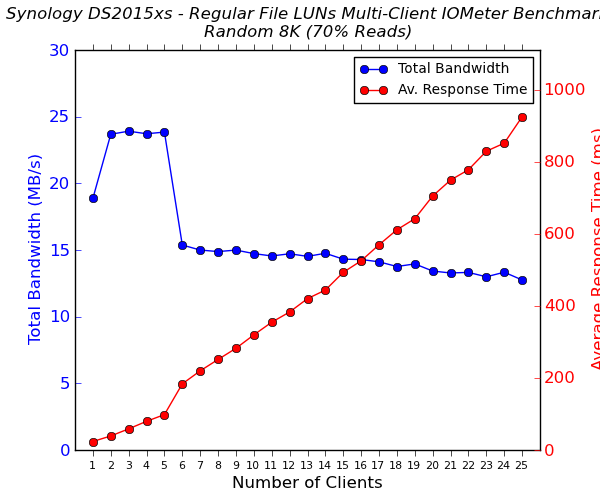Synology DS2015xs Review: An ARM-based 10G NAS
by Ganesh T S on February 27, 2015 8:20 AM EST- Posted in
- NAS
- Storage
- Arm
- 10G Ethernet
- Synology
- Enterprise
Multi-Client iSCSI Evaluation
As virtualization becomes more and more popular even in home / power user settings, the importance of the iSCSI feature set of any COTS NAS can't be overstated. Starting with our ioSafe 1513+ review, we have started devoting a separate section (in the reviews of NAS units targeting SMBs and SMEs) to the evaluation of iSCSI performance. Since we have already looked at the way iSCSI LUNs are implemented in DSM in the ioSafe 1513+ review, it won't be discussed in detail.
We evaluated the performance of the Synology DS2015xs with file-based LUNs as well as configuring a RAID-5 disk group with single as well as multiple LUNs. The standard IOMeter benchmarks that we used for multi-client CIFS evaluation were utilized for iSCSI evaluation also. The main difference to note is that the CIFS evaluation was performed on a mounted network share, while the iSCSI evaluation was done on a 'clean physical disk' (from the viewpoint of the virtual machine).
Performance Numbers
The four IOMeter traces were run on the physical disk manifested by mapping the iSCSI target on each VM. The benchmarking started with one VM accessing the NAS. The number of VMs simultaneously playing out the trace was incremented one by one till we had all 25 VMs in the fray. Detailed listings of the IOMeter benchmark numbers (including IOPS and maximum response times) for each configuration are linked below:
- Synology DS2015xs - 8 SSDs / RAID-5 / 2x 10G - LUNs (Regular Files)
- Synology DS2015xs - 8 SSDs / RAID-5 / 2x 10G - Single LUN on RAID
- Synology DS2015xs - 8 SSDs / RAID-5 / 2x 10G - Multiple LUNs on RAID




The observations we had in the previous section hold true here also. In general, the performance of the DS2015xs iSCSI volumes is better than the others that are presented as comparison points, even considering the SSD vs. HDD aspect.










49 Comments
View All Comments
M4stakilla - Monday, March 2, 2015 - link
I currently have a 1TB M550 and 6x 4TB desktop HDDs (will expand to 8x) in RAID5 + an offline backup (5x 4TB)So nothing exceeds 500MB/sec and no real upgrade plans for that either
but it would be a a shame to waste 400MB/sec of the 500MB/sec on stupid network limitations
4x 1Gbit teamed might be worth a look though, thanks
usernametaken76 - Friday, February 27, 2015 - link
Yes, a Mac Mini with Thunderbolt and, just one example, a LaCie 5big Thunderbolt (in sizes from 10 to 30 TB) does offer exactly this, almost times 2. The Thunderbolt 2 models, even more. These are geared more towards video editing but provides every bit of the bandwidth you crave.M4stakilla - Sunday, March 1, 2015 - link
Thanks for the advice!Looking further into Thunderbolt... Cabling seems quite expensive though : 300+ euro for 10m, 500+ euro for 20m :(
Out of ethical reasons, I'm trying to avoid Apple at all costs, so no Mac Mini for me...
Also the LaCie 5big is a bit silly, as I already have the HDDs and the LaCie is including HDDs.
usernametaken76 - Tuesday, March 3, 2015 - link
You can get four drive empty Thunderbolt cases from OWC. And of course a PC motherboard with Thunderbolt are available via add-in card, Asus makes a good Z97 board for about $400 with everything but the kitchen sink. Not sure why you're seeing such high prices for a 10m cable. They shouldn't be more than $50 for a 6m cable. They were working on optical cable extensions to the original copper cabling (with Mini-DP headers)..perhaps that's what you're seeing?usernametaken76 - Tuesday, March 3, 2015 - link
Make that $39 for a 2m cable. I believe you are looking at active optical cables that you wouldn't need unless you have to have a very long run for some reason. Is there a reason the storage has to be so far away from the workstation?DCide - Friday, February 27, 2015 - link
I'm unclear about the DAS tests. It appears you were testing throughput to a single Windows Server 2012 client. I would expect the ATTO read throughput to top out at around 1200MBps, and the real-world read performance to top out around 900-950MBps, as it did.I thought teaming didn't usually increase throughput to a single client from the same source. I imagine Synology's claim of around 1900MBps throughput will pan out if two clients are involved, perfectly inline with your real-world throughput of 950MBps to a single client.
usernametaken76 - Friday, February 27, 2015 - link
A single client with multiple transfers would be treated as such.usernametaken76 - Friday, February 27, 2015 - link
That is, provided the single client also has teaming configured.DCide - Friday, February 27, 2015 - link
I think teaming was configured - that was the point of using Windows Server 2012 for the client, if I understood correctly.So it would appear that both tests (ATTO & real world) only consisted of a single transfer. I don't see any evidence that two Blu-ray folders were transferred concurrently, for example.
ganeshts - Friday, February 27, 2015 - link
Our robocopy tests (real world) were run with MT:32 option. The two Emulex SFP+ ports on Windows Server 2012 were also teamed. In one of the screenshots, you can actually see them even treated separately (no teaming) and iPerf reporting around 2.8 Gbps each. In the teamed case, iPerf was reporting around 5 Gbps. iPerf was run with 16 simultaneous transfers.I will continue to do more experiments with other NAS units to put things in perspective in future reviews. As of now, this is a single data point for the Synology DS2015xs.